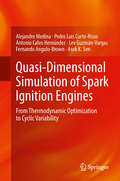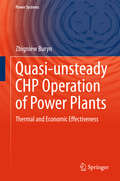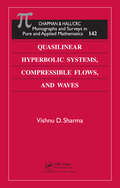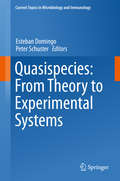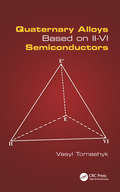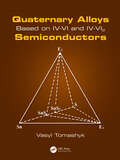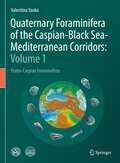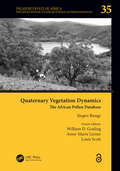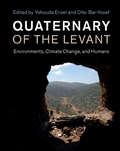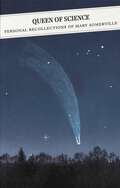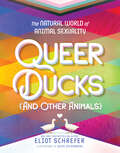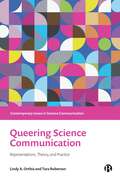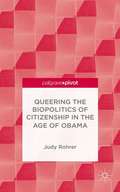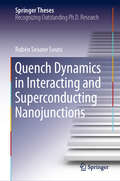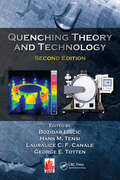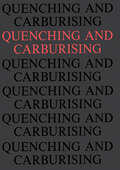- Table View
- List View
Quasi-Dimensional Simulation of Spark Ignition Engines: From Thermodynamic Optimization to Cyclic Variability
by Antonio Calvo Hernández Lev Guzmán-Vargas Asok K Sen Fernando Angulo-Brown Pedro Luis Curto-Risso Alejandro MedinaBased on the simulations developed in research groups over the past years, Introduction to Quasi-dimensional Simulation of Spark Ignition Engines provides a compilation of the main ingredients necessary to build up a quasi-dimensional computer simulation scheme. Quasi-dimensional computer simulation of spark ignition engines is a powerful but affordable tool which obtains realistic estimations of a wide variety of variables for a simulated engine keeping insight the basic physical and chemical processes involved in the real evolution of an automotive engine. With low computational costs, it can optimize the design and operation of spark ignition engines as well as it allows to analyze cycle-to-cycle fluctuations. Including details about the structure of a complete simulation scheme, information about what kind of information can be obtained, and comparisons of the simulation results with experiments, Introduction to Quasi-dimensional Simulation of Spark Ignition Engines offers a thorough guide of this technique. Advanced undergraduates and postgraduates as well as researchers in government and industry in all areas related to applied physics and mechanical and automotive engineering can apply these tools to simulate cyclic variability, potentially leading to new design and control alternatives for lowering emissions and expanding the actual operation limits of spark ignition engines
Quasi-Exactly Solvable Models in Quantum Mechanics
by A.G UshveridzeExactly solvable models, that is, models with explicitly and completely diagonalizable Hamiltonians are too few in number and insufficiently diverse to meet the requirements of modern quantum physics. Quasi-exactly solvable (QES) models (whose Hamiltonians admit an explicit diagonalization only for some limited segments of the spectrum) provide a practical way forward.Although QES models are a recent discovery, the results are already numerous. Collecting the results of QES models in a unified and accessible form, Quasi-Exactly Solvable Models in Quantum Mechanics provides an invaluable resource for physicists using quantum mechanics and applied mathematicians dealing with linear differential equations. By generalizing from one-dimensional QES models, the expert author constructs the general theory of QES problems in quantum mechanics. He describes the connections between QES models and completely integrable theories of magnetic chains, determines the spectra of QES Schrödinger equations using the Bethe-Iansatz solution of the Gaudin model, discusses hidden symmetry properties of QES Hamiltonians, and explains various Lie algebraic and analytic approaches to the problem of quasi-exact solubility in quantum mechanics.Because the applications of QES models are very wide, such as, for investigating non-perturbative phenomena or as a good approximation to exactly non-solvable problems, researchers in quantum mechanics-related fields cannot afford to be unaware of the possibilities of QES models.
Quasi-Geostrophic Theory of Oceans and Atmosphere
by Fabio Cavallini Fulvio CriscianiLarge-scale winds and currents tend to balance Coriolis and pressure gradient forces. The time evolution of these winds and currents is the subject of the quasi-geostrophic theory. Chapter 1 presents concepts and equations of classical inertial fluid mechanics. Chapter 2 deals with the equations of thermodynamics that close the governing equations of the fluids. Then, the motion is reformulated in a uniformly rotating reference frame. Chapter 3 deals with the shallow-water model and the homogeneous model of wind-driven circulation. The chapter also describes a classical application of the Ekman layer to the atmosphere. Chapter 4 considers the two-layer model, as an introduction to baroclinic flows, together with the concept of available potential energy. Chapter 5 takes into account continuously stratified flows in the ocean and in the atmosphere.
Quasi-unsteady CHP Operation of Power Plants
by Zbigniew BurynThis book analyzes the continuous operation of a power plant with condensing power units in combined heat and power mode (CHP-mode) over a period of one year. Focusing on the operation of one and two power-unit systems with differing heat exchanger configurations, this book uses mathematical modeling of the steam-water cycle of a 370 MW power unit to calculate the operating characteristics and mass-energy balance of the system. Featuring comprehensive thermodynamic analysis of the quasi-unsteady operation of power units in cogeneration for electrical power generation, as determined by the Polish Power System, this work also includes an economic analysis of the power plant, presenting the costs and economic effectiveness of such a system.
Quasicrystals: Fundamentals and Applications
by Enrique Maciá-Barberpromoting the very notion of quasiperiodic order, and to spur its physical implications and technological capabilities. It, therefore, explores the fundamental aspects of intermetallic, photonic, and phononic quasicrystals, as well as soft-matter quasicrystals, including their intrinsic physical and structural properties. In addition, it thoroughly discusses experimental data and related theoretical approaches to explain them, extending the standard treatment given in most current solid state physics literature. It also explores exciting applications in new technological devices of quasiperiodically ordered systems, including multilayered quasiperiodic systems, along with 2D and 3D designs, whilst outlining new frontiers in quasicrystals research. This book can be used as a reader-friendly introductory text for graduate students, in addition to senior scientists and researchers coming from the fields of physics, chemistry, materials science, and engineering. Key features: • Provides an updated and detailed introduction to the interdisciplinary field of quasicrystals in a tutorial style, considering both fundamental aspects and additional freedom degrees provided by designs based on quasiperiodically ordered materials. • Includes 50 fully worked out exercises with detailed solutions, motivating, and illustrating the different concepts and notions to provide readers with further learning opportunities. • Presents a complete compendium of the current state of the art knowledge of quasicrystalline matter, and outlines future next generation materials based on quasiperiodically ordered designs for their potential use in useful technological devices. Dr. Enrique Maciá-Barber is Professor of condensed matter physics at the Universidad Complutense de Madrid. His research interests include the thermoelectric properties of quasicrystals and DNA biophysics. In 2010 he received the RSEF- BBVA Foundation Excellence Physics Teaching Award. His book Aperiodic Structures in Condensed Matter: Fundamentals and Applications (CRC Press, Boca-Raton, 2009) is one of the Top Selling Physics Books according to YBP Library Services.
Quasilinear Hyperbolic Systems, Compressible Flows, and Waves
by Vishnu D. SharmaFilled with practical examples, Quasilinear Hyperbolic Systems, Compressible Flows, and Waves presents a self-contained discussion of quasilinear hyperbolic equations and systems with applications. It emphasizes nonlinear theory and introduces some of the most active research in the field.After linking continuum mechanics and quasilinear partial di
Quasispecies: From Theory to Experimental Systems
by Peter Schuster Esteban DomingoThis volume brings together recent developments in quasispecies theory extended to variable environments and practical applications in elucidating viral dynamics and treatment designs. In particular, the existence of an error threshold in rugged fitness landscapes has opened the way to a new antiviral strategy termed lethal mutagenesis, which is now under intensive theoretical, experimental and clinical investigation. As such the book explains how an understanding of quasispecies dynamics within infected organisms has increased our knowledge of viral disease events. From a clinical perspective, population dynamics highlights important problems for viral disease control, such as the selection of drug-resistant mutants that often accompanies treatment failures, and suggests means of increasing the effectiveness of antiviral treatments. The book is intended for students and scientists interested in basic and applied aspects of biophysics, chemistry, biology, evolution and medical virology.
Quaternary Alloys Based on II - VI Semiconductors
by Vasyl TomashykDoped by isovalent or heterovalent foreign impurities, II-VI semiconductor compounds enable control of optical and electronic properties, making them ideal in detectors, solar cells, and other precise device applications. Quaternary alloys allow a simultaneous adjustment of band gap and lattice constant, increasing radiant efficiency at a wide rang
Quaternary Alloys Based on III-V Semiconductors
by Vasyl TomashykBoca Raton : CRC Press, 2017. | Includes index
Quaternary Alloys Based on IV-VI and IV-VI2 Semiconductors
by Vasyl TomashykIV–VI and IV–VI2 semiconductors have attracted considerable attention due to their applications in the fabrication of electronic and optoelectronic devices as light-emitting diodes and solar cells. The electrical properties of these semiconductors can also be tuned by adding impurity atoms. Because of their wide application in various devices, the search for new semiconductor materials and the improvement of existing materials is an important field of study. Doping with impurities is a common method of modifying and diversifying the properties of physical and chemical semiconductors. This book covers all known information about phase relations in quaternary systems based on IV–VI and IV–VI2 semiconductors, providing the first systematic account of phase equilibria in quaternary systems based on IV–VI and IV–VI2 semiconductors and making research originally published in Ukrainian and Russian accessible to the wider scientific community. This book will be of interest to undergraduate and graduate students studying materials science, solid-state chemistry, and engineering. It will also be relevant for researchers at industrial and national laboratories, in addition to phase diagram researchers, inorganic chemists, and solid-state physicists. Key Features: • Provides up-to-date experimental and theoretical information. • A source of information for synthesizing semiconducting materials with predetermined properties. • Delivers a critical evaluation of many industrially important systems presented in the form of two-dimensional sections for the condensed phases.
Quaternary Foraminifera of the Caspian-Black Sea-Mediterranean Corridors: Ponto-Caspian Foraminifera
by Valentina YankoThis handbook in two volumes offers a heretofore unavailable compilation of detailed information on foraminifera of the Caspian-Black Sea-Mediterranean Corridors (“CORRIDORS”), including their taxonomy, ecology, and applications in the study of Quaternary stratigraphy, paleogeographic reconstruction, and environmental stress. This subject is significant in light of the ongoing debates regarding the Flood Hypotheses because foraminifera can provide more information about many of the disputed questions. Foraminifera are highly reliable paleoenvironmental indicators, ubiquitous in marine environments, and taxonomically diverse, which gives them the potential for a wide range of biological responses to varied environmental factors. Their tests are readily preserved and can record evidence of environmental change through time, thus providing historical baseline data even in the absence of background studies. This book presents taxonomic descriptions for about 500 species and subspecies from the Black Sea, Sea of Azov, Caspian Sea, Aral Sea, Sea of Marmara, and the Eastern Mediterranean. This catalogue is supplemented by ecological remarks, stratigraphic distributions, paleogeography, and environmental/paleoenvironmental applications, including responses to environmental stress, e.g., river discharge, pollution by different contaminants, etc. The book will be useful to specialists in Quaternary history of the “CORRIDORS” as well as those in environmental monitoring and risk assessment. This handbook offers detailed taxonomic descriptions of foraminifera from the Black Sea, Caspian Sea, Sea of Azov, Aral Sea (in Volume 1) and Eastern Mediterranean and Sea of Marmara (in Volume 2).
Quaternary Vegetation Dynamics: The African Pollen Database (Palaeoecology of Africa #35)
by Jürgen RungeThis book celebrates the relaunch of the African Pollen Database, presents state-of-the-art of modern and ancient pollen data from sub-Saharan Africa, and promotes Open Access science. Pollen grains are powerful tools for the study of past vegetation dynamics because they preserve well within sedimentary deposits and have a huge diversity in ornamentation that allows different taxa to be determined. The reconstruction of past vegetation from the examination of ancient pollen records thus can be used to characterize the nature of past landscapes (e.g. abundance of forests vs. grasslands), provide insights into changes in biodiversity, and gain empirical evidence of vegetation response to climatic change and human activity. In this, the 35th Volume of "Palaeoecology of Africa", we bring together new data and extensive synthetic reviews to provide novel insights into the relationships between human evolution, human activity, climate change and vegetation dynamics during the Quaternary, the last 2.6 million years. Current and ongoing climate and land-use change is exerting pressure on modern vegetation formations and threatening the livelihoods and wellbeing of many peoples in Africa. In this book the focus is on the Quaternary because it is during this geological period that the modern vegetation formations developed into their current configurations against a backdrop of high magnitude global climate change (glacial-interglacial cycles), human evolution, and a growing human land-use footprint. In this book the latest information is presented and collated from around the African continent to parameterize past vegetation states, identify the drivers of vegetation change, and assess the vegetation resilience to change. To achieve this research from two broad themes are covered: (i) the present is the key to the past (i.e. studies which improve our understanding of modern environments so that we can better interpret evidence from the past), and (ii) the past is the key to the future (i.e. studies which unlock information on how and why vegetation changed in the past so one can better anticipate trajectories of future change). This Open Access book will provide a strong foundation for future research exploring past ecological, environmental and climatic change within Africa and the surrounding islands. The book is organized regionally (covering western, eastern, central, and southern Africa) and it contains specialized articles focused on particular topics (such as modern pollen-vegetation relationships and fire as a driver of vegetation change), as well as regional and pan-African syntheses drawing together decades of research to assess key scientific questions (including the role of climate in driving vegetation change and the role of vegetation change in human evolution). These articles will be useful to students and teachers from high school to the highest level of university who are interested in the origins and dynamics of vegetation in Africa. Furthermore, it is also meant to provide societally relevant information that can act as an inspiration for the development of sustainable management practices for the future.
Quaternary of South America and Antarctica Peninsula 1998
by JORGE RABASSA; MÓNICA SALEMMEThis text deals with certain geological aspects of the extreme geographical locations of South America and the Antarctic Peninsula. Topics include: Brazil - geology and vertebrate paleontology; pleistocene wave-built terraces of Northern Rio de Janeiro state; and holocene coastal evolution.
Quaternary of the Levant: Environments, Climate Change, and Humans
by Yehouda Enzel Bar-Yosef OferQuaternary of the Levant presents up-to-date research achievements from a region that displays unique interactions between the climate, the environment and human evolution. Focusing on southeast Turkey, Lebanon, Syria, Jordan and Israel, it brings together over eighty contributions from leading researchers to review 2. 5 million years of environmental change and human cultural evolution. Information from prehistoric sites and palaeoanthropological studies contributing to our understanding of 'out of Africa' migrations, Neanderthals, cultures of modern humans, and the origins of agriculture are assessed within the context of glacial-interglacial cycles, marine isotope cycles, plate tectonics, geochronology, geomorphology, palaeoecology and genetics. Complemented by overview summaries that draw together the findings of each chapter, the resulting coverage is wide-ranging and cohesive. The cross-disciplinary nature of the volume makes it an invaluable resource for academics and advanced students of Quaternary science and human prehistory, as well as being an important reference for archaeologists working in the region.
Que Se Yo de Geografia
by Kenneth C. DavisAcompáñanos mientras Kenneth C. Davis, autor del bestseller Qué Sé Yo de Historia, nos lleva en un fascinante, asombroso y divertidísimo tour del planeta Tierra -- una excursión que nos abrirá los ojos y la imaginación a un extenso, salvaje y sorprendente mundo que no conocíamos.
Que la ciencia te acompañe: A luchar por tus derechos
by Agostina MileoDatos científicos de los temas clave en la agenda de género para sostener la crítica feminista. Aunque la humanidad no está formada solo por varones blancos heterosexuales, ellos son el modelo con que el mundo todo se organiza y se piensa. El sexo, la economía, la salud, la tecnología, incluso la ciencia -amparada por una supuesta neutralidad y objetividad-, refuerza estereotipos patriarcales que pasan desapercibidos la mayoría de las veces. Por suerte, Agostina Mileo confronta con sensatez los prejuicios y desarma con lenguaje claro e información accesible, cada uno de los lugares comunes en los que se arraiga el machismo, abriendo la discusión sobre temas como la "utilidad" de los orgasmos, las diferencias entre el cerebro "femenino" o "masculino" (¿y trans?), las falacias sobre el aborto y los mitos de la menstruación. Con irreverencia, demuestra por qué es imperioso construir una mirada crítica y diversa sobre la producción y comunicación del conocimiento, y cuestionar nuestras propias opiniones una y otra vez. En la lucha por una sociedad igualitaria, necesitamos que también ¡la ciencia nos acompañe!
Queen Bey: A Celebration of the Power and Creativity of Beyoncé Knowles-Carter
by Veronica ChambersFEATURED IN: The New York Times Book Review ("New and Noteworthy") •Essence • Newsweek•People • Bustle • PopSugar • Refinery 29 • HelloGiggles' • PureWow • Newsday• AMNewYorkThe Ultimate Beyoncé Collectible"Beyoncé fans will eat it up." —People"You don't need to be in the Beyhive to appreciate Queen Bey...Voices including culture critic Luvvie Ajayi and actress and producer Lena Waithe give us a fresh take on Beyoncé, who's arguably the biggest pop star of our time." —EssenceBeyoncé. Her name conjures more than music, it has come to be synonymous with beauty, glamour, power, creativity, love, and romance. Her performances are legendary, her album releases events. She is not even forty but she has already rewritten the Beyoncé playbook more than half a dozen times. She is consistently provocative, political and surprising. As a solo artist, she has sold more than 100 million records. She has won 22 Grammys and is the most-nominated woman artist in the history of Grammy awards. Her 2018 performance at Coachella wowed the world. The New York Times wrote: "There's not likely to be a more meaningful, absorbing, forceful and radical performance by an American musician this year or any year soon." Artist, business woman, mother, daughter, sister, wife, black feminist, Queen Bey is endlessly fascinating. Queen Bey features a diverse range of voices, from star academics to outspoken cultural critics to Hollywood and music stars. Essays include:"What Might a Black Girl Be in This World," an introduction by Veronica Chambers"Beychella is Proof That Beyoncé is the Greatest Performer Alive. I’m Not Arguing." by Luvvie Ajayi"On the Journey Together," by Lena Waithe"What Beyoncé Means to Everyone," by Meredith Broussard with visualizations by Andrew Harvard and Juan Carlos Mora"Jay-Z's Apology to Beyoncé Isn't Just Celebrity Gossip — It's a Political Act" by Brittney Cooper"All Her Single Ladies" by Kid Fury "The Elevator" by Ylonda Gault "The Art of Being Beyoncé" by Maria Brito"Getting, Giving and Leaving" by Melissa Harris Perry and Mankaprr Conteh"Beyoncé the Brave" by Reshma Saujani"Living into the Lemonade: Redefining Black Women’s Spirituality in the Age of Beyoncé" by Candice Benbow"Beyoncé’s Radical Ways" by Carmen Perez"Finding la Reina in Queen Bey" by Isabel Gonzalez Whitaker"Beyoncé, Influencer" by Elodie Maillet Storm"The King of Pop and the Queen of Everything" by Michael Eric Dyson"Style So Sacred" by Edward Enninful"The Beauty of Beyoncé" by Fatima Robinson "Because Beyoncé." by Ebro Darden"King Bey" by Treva B. Lindsey"Meridonial: Beyoncé’s Southern Roots and References" by Robin M. Boylorn"B & V: A Love Letter" by Caroline Clarke
Queen Caroline and Sir William Gell: A Study in Royal Patronage and Classical Scholarship (Queenship and Power)
by Jason ThompsonThis book explores the relationship between Queen Caroline, one of the most enigmatic characters in Regency England, and Sir William Gell, the leading classical scholar of his day. Despised and rejected by her husband, Caroline created a sphere and court of her own through patronage of scholarship. The primary beneficiary was Gell, a pioneering scholar of the classical world who opened new dimensions in the study of ancient Troy, mainland Greece, and Ithaca. Despite his achievements, Gell had scarce financial resources. Support from Caroline enabled him to establish himself in Italy and conduct his seminal work about ancient Rome and, especially, Pompeii, until her sensational trial before the House of Lords and premature death. Concluding with the first scholarly transcription of the extraordinary series of letters that Caroline wrote to Gell, this volume illuminates how Caroline sought power through patronage, and how Gell shaped classical scholarship in nineteenth-century Britain.
Queen of Science: Personal Recollections of Mary Somerville (Canongate Classics #102)
by Mary SomervilleThe complete memoirs of the 19th century scientist, public intellectual, and first female member of the Royal Astronomical Society.Born in Jedburgh in 1780, Mary Fairfax was the daughter of a captain in Lord Nelson&’s navy. In common with most girls of her time and station, she received an education that prized gentility over ability. Nevertheless, she taught herself algebra in secret, and made her reputation in celestial mechanics with her 1831 translation of Laplace&’s Mécanique céleste as The Mechanism of the Heavens.A brilliant polymath with interests in art, literature and nature, Somerville&’s memoirs give a fascinating picture of her life and times from childhood in Burntisland to international recognition and retirement in Naples. She recounts memories of comets and eclipses, high society in London and Paris, Charles Babbage and his calculating engine, encounters with Sir Walter Scott and Fenimore Cooper, the Risorgimento in Italy and the eruption of Vesuvius.Selected by her daughter and first published in 1973, these are the memoirs of a remarkable woman who became one of the nineteenth century&’s most accomplished mathematicians and scientists. Oxford&’s Somerville College was named after her, and the present volume, re-edited by Dorothy McMillan, draws on manuscripts owned by the college, offering the first unexpurgated edition of these revelatory writings.
Queer Ducks (and Other Animals): The Natural World of Animal Sexuality
by Eliot SchreferThis groundbreaking illustrated YA nonfiction title from two-time National Book Award finalist and New York Times bestselling author Eliot Schrefer is a well-researched and teen-friendly exploration of the gamut of queer behaviors observed in animals.A quiet revolution has been underway in recent years, with study after study revealing substantial same-sex sexual behavior in animals. Join celebrated author Eliot Schrefer on an exploration of queer behavior in the animal world—from albatrosses to bonobos to clownfish to doodlebugs.In sharp and witty prose—aided by humorous comics from artist Jules Zuckerberg—Schrefer uses science, history, anthropology, and sociology to illustrate the diversity of sexual behavior in the animal world. Interviews with researchers in the field offer additional insights for readers and aspiring scientists.Queer behavior in animals is as diverse and complex—and as natural—as it is in our own species. It doesn’t set us apart from animals—it bonds us even closer to our animal selves.
Queering Science Communication: Representations, Theory, and Practice
by Lindy A. Orthia and Tara RobersonA book on queer themes and science communication is timely, if not well overdue. LGBTIQA+ people have unique contributions to make and issues to meet through science communication. So, bringing ‘queer’ and ‘science communication’ together is an important step for queer protest, liberation, and visibility. This collection examines the place of queer people within science communication and asks what it means for the field to ‘queer’ science communication practice, theory and research agendas. Written by leading names in the field, it offers concrete examples for academics, students and practitioners who strive to foster radical inclusivity and equity in science communication.
Queering the Biopolitics of Citizenship in the Age of Obama
by Judy RohrerWhere dominant citizenship narratives have heretofore focused on either the state or the nation as qualifiers of belonging, this book draws from the interdisciplinary fields of queer theory, critical race theory, feminist political theory, disability studies, and indigenous studies to further an evolving discussion of what it means to be an American citizen in the Obama era. Rohrer demonstrates that this discussion requires an understanding of the machinations of governmentality and biopolitics in the (re)production of the (proper) citizen.
Quench Dynamics in Interacting and Superconducting Nanojunctions (Springer Theses)
by Rubén Seoane SoutoEffects of many-body interactions and superconducting correlations have become central questions in the quantum transport community. While most previous works investigating current fluctuations in nanodevices have been restricted to the stationary regime, Seoane's thesis extends these studies to the time domain. It provides relevant information about the time onset of electronic correlations mediated by interactions and superconductivity. This knowledge is essential for the development of fast electronic devices, as well as novel applications requiring fast manipulations, such as quantum information processing. In addition, the thesis establishes contact with issues of broad current interest such as non-equilibrium quantum phase transitions.
Quenching Theory and Technology
by George E. Totten Hans M. Tensi Božidar Liščić Lauralice C. F. CanaleQuenching is one of the most fundamentally complex processes in the heat treatment of metals, and it is something on which mechanical properties and distortion of engineering components depend. With chapters written by the most respected international experts in the field, Quenching Theory and Technology, Second Edition presents the most authoritat
Quenching and Carburising: Proceedings of the 3rd International Seminar of the International Federation for Heat Treatment (Melbourne, 1991)
by Peter D. HodgsonProceedings of the 3rd International Seminar of the International Federation for Heat Treatment held in Melbourne, in 1991 with the special focus on ‘Quenching and Carburising’. Quenching and Carburising are two of the most basic and widely practised steel heat treatment processes. Each allows the base properties and performance of the steel to be significantly enhanced, such that a relatively inexpensive and simple starting material can be used for a wide range of demanding applications. Nevertheless, the technological developments within those two processes are often ignored in favour of ‘high tech’ surface treatments. The aim of Quenching and Carburising was to review the recent advancements that have been made in these fields.
